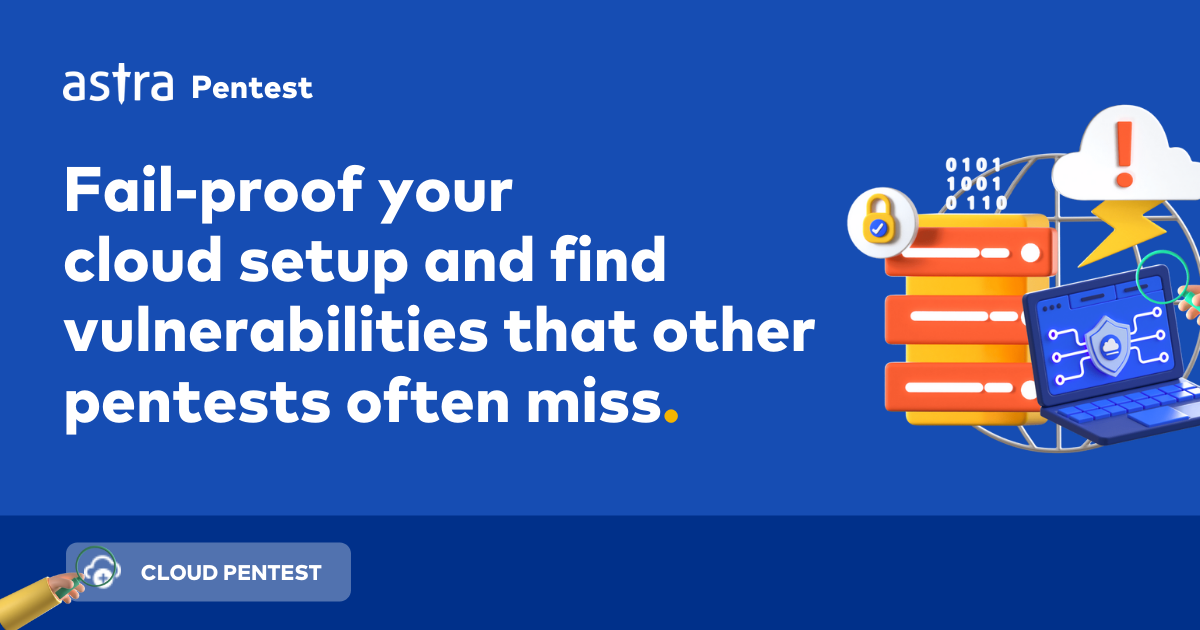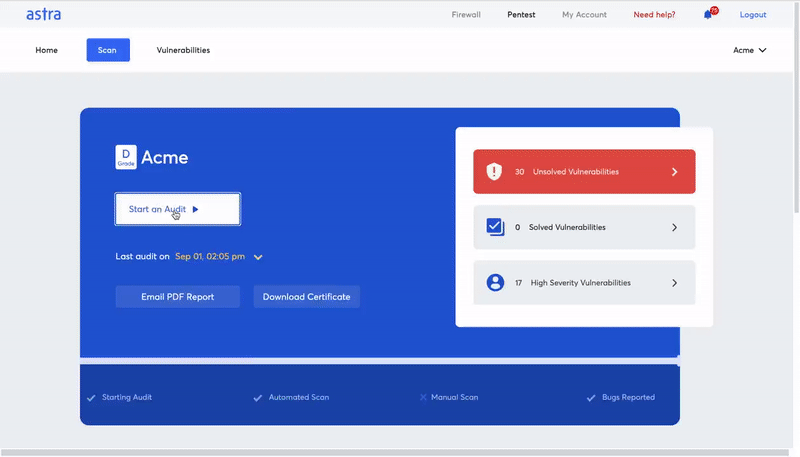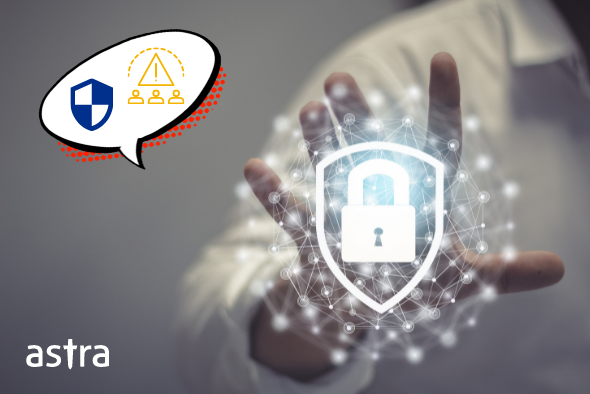The rapid movement of organizations from on-premises to Software as a Service (SaaS) has plenty of catalysts behind it. Therefore SaaS security is a crucial component for a seamless experience and a trusty relationship between the SaaS provider and the customer.
It is prudent to make sure that the security posture of SaaS in place has good logical reasoning behind it without any scope for a breach or theft. This is where SaaS Security Management plays a vital role.
Without further ado, let us discuss what SaaS security management is, its features, its importance, 6 key components, and the top risks associated with SaaS security.
What Is SaaS Security Management?
SaaS security management is the process of tracking components of one’s SaaS application security using automated tools to aid in the effective management of SaaS security. SaaS security posture management (SSPM) continuously monitors applications to analyze a deviation in security posture, the presence of risks and adherence to updated compliance.
6 Key Components of SaaS Security Management
- Data Protection
- Identity Access Management
- Regular Pentest
- Continuous Vulnerability Assessment
- Ensuring Compliance
- Security Checklist
Let us now check out some of the features of SaaS security management to help us understand its function even better.
Features Of SaaS Security Management
Here we have some of the features that make SaaS security management a dynamic option for the ever-evolving and changing needs of SaaS security:
- It builds on existing protective SaaS measures like cloud access security brokers (CASB), penetration testing, and software for ensuring compliance and security.
- It is dynamic thereby being constantly vigilant while providing newer preventative measures against vulnerabilities.
- It considers and ensures the individual security needs of every stakeholder.
- It monitors the SaaS applications for any deviation from its established security measures.
- Makes sure that the SaaS applications are always compliant with the industry-established regulations.
Read more- SaaS Security Audit in 7 Steps
Relevance for SaaS Security Management for SaaS Solution Providers
- Helps with compliance
SaaS security management helps the SaaS applications remain continuously compliant with compliance frameworks stipulated by their respective industries through constant vigilance.
- Assistance To Sales Team
It is important for sales team pitches since good SaaS security management can act as an alluring attribute for customers and thus increase the number of contracts.
- Confidence Boost
Provides the customers with a major confidence boost through the thorough safety measures in place to protect their applications and data continuously.
- Ensured Customer Data Security
Customer data security is of prime importance and therefore assured. Since there is continuous monitoring, the SaaS security management is always up-to-date on the latest security issues that have risen in applications and external libraries they make use of.
Also Read: Cloud Security Audit: Everything You Need to Know
Importance Of SaaS Security Management For Organizations Choosing A SaaS Provider
- Seamless Vetting
Makes it easier for organizations to vet their possible choices for SaaS providers by thoroughly analyzing the SaaS security measures they have in place to protect customer applications and data.
- Compliance-based Selection/Eligibility
Also helps narrow down their options based on how well the SaaS provider is compliant with international security standards, thus making the conscientiously compliant SaaS providers the more appealing candidate for the organization’s needs.
- Secure Handling of Data
Having competent SaaS security management in place ensures that the customer data that is shared by organizations with the SaaS provider is always handled with the utmost security.
Also Read: 5 SaaS Security Certifications to Wrap Your Head Around

Top SaaS Security Risks
In this section, we will discuss the topmost SaaS security risks every SaaS provider and customer needs to be aware of such as threats to data and identity management. We will cover security risks related to:
Recently, companies like Microsoft, HubSpot, and Okta went through significant breaches of data security. Microsoft faced a data breach through a single account from which the source code was accessed and published, however, it was clarified that no information was compromised.
In HubSpot’s case, it was through the employee access for employees through which customer data of several accounts were accessed. Okta was hacked by the same group that did Microsoft and was done by compromising a software engineer’s computer using a remote desktop protocol.
With such recent scenarios fresh in the minds of SaaS providers and customers, it makes sense that staying current on the topmost risks would be a priority, therefore let’s keep reading.
1. Data Security
The security of one’s data stored on SaaS cloud servers is one of the crucial aspects of SaaS data security. However, it is seen that data security breaches and subsequent data theft are also unignorable aspects of storing sensitive data on the cloud.
Such data theft can also lead to accessing employee account credentials and using them for malicious purposes. It also brings into question the efficacy of the existing security solutions thus causing a dissent when it comes to trusting the SaaS provider with sensitive client information.
2. Access management
Since all the data of SaaS customer applications and client data are stored with a third party, it is critical to ensure that single-point access into the cloud infrastructure will not result in confidential data exposure. This could occur through unauthorized access resulting in data deletion or leakage. Ensure that you know enough and more about the security systems put in place by the SaaS provider to limit and control access based on access levels thereby saving yourself from trouble later.
3. Misconfigurations
Misconfigurations occur when proper measures aren’t taken to ensure the security of the cloud. This leads to compromised data security which can occur from both the SaaS provider and customer’s end. Complex hierarchies within the SaaS systems often provide a larger venue for such misconfigurations to take place. They can result in malware, ransomware, and phishing attacks all of which could lead to data leaks and theft.
4. Non-Compliance
Even if a SaaS customer follows and is compliant with all the regulations and frameworks adopted by them to ensure a seamless cybersecurity experience if the SaaS vendors are not compliant it put your application at risk for non-compliance too.
Fines and penalties are imposed on cloud providers and customers who do not adhere to regulatory standards set in place for SaaS security. Not ensuring whether SaaS customers are compliant with GDPR, HIPAA, or whichever regulatory standard was adopted or whether SaaS providers have relevant certifications for security like ISO and more can result in non-compliance of a high magnitude.
5. Disaster Recovery
Incident response or disaster recovery is an essential aspect of SaaS security that should not be overlooked. It is always prudent to enquire about the systems in place to manage any problems that could arise from natural disasters and how the recovery would take place. Not having a proper disaster response in place or if the recovery procedure takes very long can have a major impact on the SaaS customer’s application and their clients. If full restoration of data isn’t possible that could result in hefty losses for the customers.
6 Key Components of SaaS Security Management
Listed below are a few of the key components of cloud SaaS security management that ensure a high level of security.
- Data Protection
Preventing a data breach has to be a major area of focus for a SaaS provider. This can be done by employing data encryption during transits and even at rest. TLS or transport layer security is employed to protect data that is being passed along various SaaS applications.
Another practice that is made use of is to offer the SaaS customers control over their encryption keys so that staff from the SaaS provider end cannot decrypt customer data. Ways to ensure the security of data at rest include ensuring a hierarchy of security levels with encryption on both ends and conducting audits regularly.
2. Identity Access Management
Identity access management is a system by which every user is vetted to their identity as well as determining whether the user has the right to use or download data from a SaaS application. Simply put the system works to authenticate, authorize and audit users from the activities on a SaaS platform that are permitted or not permitted to carry out.
Identity access management also allows for role-based access control and multi-factor authentication where users have to submit at least two proofs of identity.
3. Regular Pentests
Periodically conducting pentests or penetration tests can gauge the extent of the vulnerabilities that can be exploited. They provide targeted hacker-style attacks that comb through all aspects (with permission) of an application to find vulnerabilities that could be exploited by real hackers. At the end of a pentest, the organization is given a detailed report with recommendations for patches and security fixes that needs to be implemented to ensure impenetrable security.
Before carrying out the tests, however, the scope of the tests, assets, and permissions all must be discussed with the pentesters to help with a more targeted approach to pentesting. It is a good idea to employ SaaS security services to help you take care of the security testing process.
4. Continuous Vulnerability Assessment
Continuous vulnerability assessments are yet another area that needs to be kept in mind always. Vulnerability assessments help assess the security system to find vulnerabilities and loopholes within the system. For this, you should look for a scanner that you can integrate with your CI/CD pipeline, thus ensuring the continuous testing of new features and updates.
These are different from penetration tests in the sense there are no hacker-style attacks, but just a thorough check-through of the security system to find any vulnerabilities. After the assessment, a report is given to the organization to fix any security weaknesses for better-updated security.
Read more- Checklist For Vulnerability Assessment
5. Ensuring Compliance
Compliance with regulatory standards set in place helps SaaS customers and providers alike to avoid hefty fines and other possible actions. Continuous assessment of compliance is necessary to ensure that the SaaS application does not deviate from its baseline security measures. Manual tracking of such compliance statuses of multiple applications and vendors is a cumbersome task that can be eased by opting for automated tracking options. If any areas of non-compliance are found, they have to be immediately remedied.
6. Security Checklist
Having a security checklist is vital for ease in transitioning from one phase to another without any glitched or doubts regarding what has to be done next. It can also be used periodically to check on one’s SaaS security systems to ensure everything is functioning properly.
For SaaS application customers, such an aspect is crucial because it allows them to judge and make an informed choice regarding which SaaS vendor is apt for their needs, based on who fulfills their security checklist better.
The checklist maintained should focus on SaaS security posture management solutions, employee training, strong password policies, classification of data based on the security level, and enforcing stringent security regulations and encryption.
Choosing The Right SaaS Security Testing Provider
Choosing the right saas security company for your organization can be a tedious task, but it can be made easy by keeping some factors in mind while making the decision, they include:-
- Experience of the SSPM solution.
- Transparent communication and clarification.
- A focus on knowledge and certification acquired by the company.
- Availability of economical and highly comprehensive packages.
- Duration for testing and the interactive skills of the testers.

Astra Security- The Perfect Solution
Conducting regular penetration tests on your SaaS application is a vital part of healthy SaaS security management. This is where Astra Security swoops in with the right features and solutions. Astra’s Pentest Suite is a one-stop destination for all your SaaS security management and testing needs. Here are a few reasons why Astra should be your top choice-
- More than 8000+ tests to ensure that all security vulnerabilities can be found.
- Integration with CI/CD tools, GitLab, Jira, and Slack is possible with Astra.
- Assured zero false positives through thorough automated and manual testing.
- A publicly verifiable Pentest certificate increases your organization’s trustworthiness.
- Experienced pentesters at Astra provide manual support and continuous collaboration to ensure a smooth, hassle-free testing experience for your organization.
- Affordable and highly comprehensive monthly and yearly packages to choose from based on your needs.
Conclusion
Hope this article has enlightened you on the need and relevance of SaaS security management for both SaaS vendors and customers, the risks associated with the improper implementation of SaaS security as well the key components of SaaS security management that make it a winning solution to ease your worries!
FAQs
1. What Is SaaS Security Management?
SaaS security management is an automated process through which all the components of SaaS security can be monitored continuously.
2. What are the top SaaS security risks?
The topmost SaaS security risks include non-compliance, misconfigurations, improper access management, and data security.
3. What are the best practices in SaaS security?
The best practices to be followed for a well-rounded SaaS security are data protection through encryption, implementation of Identity Access Management, continuous penetration tests, and vulnerability assessments.

















This was very very informative, Thank you very much😊